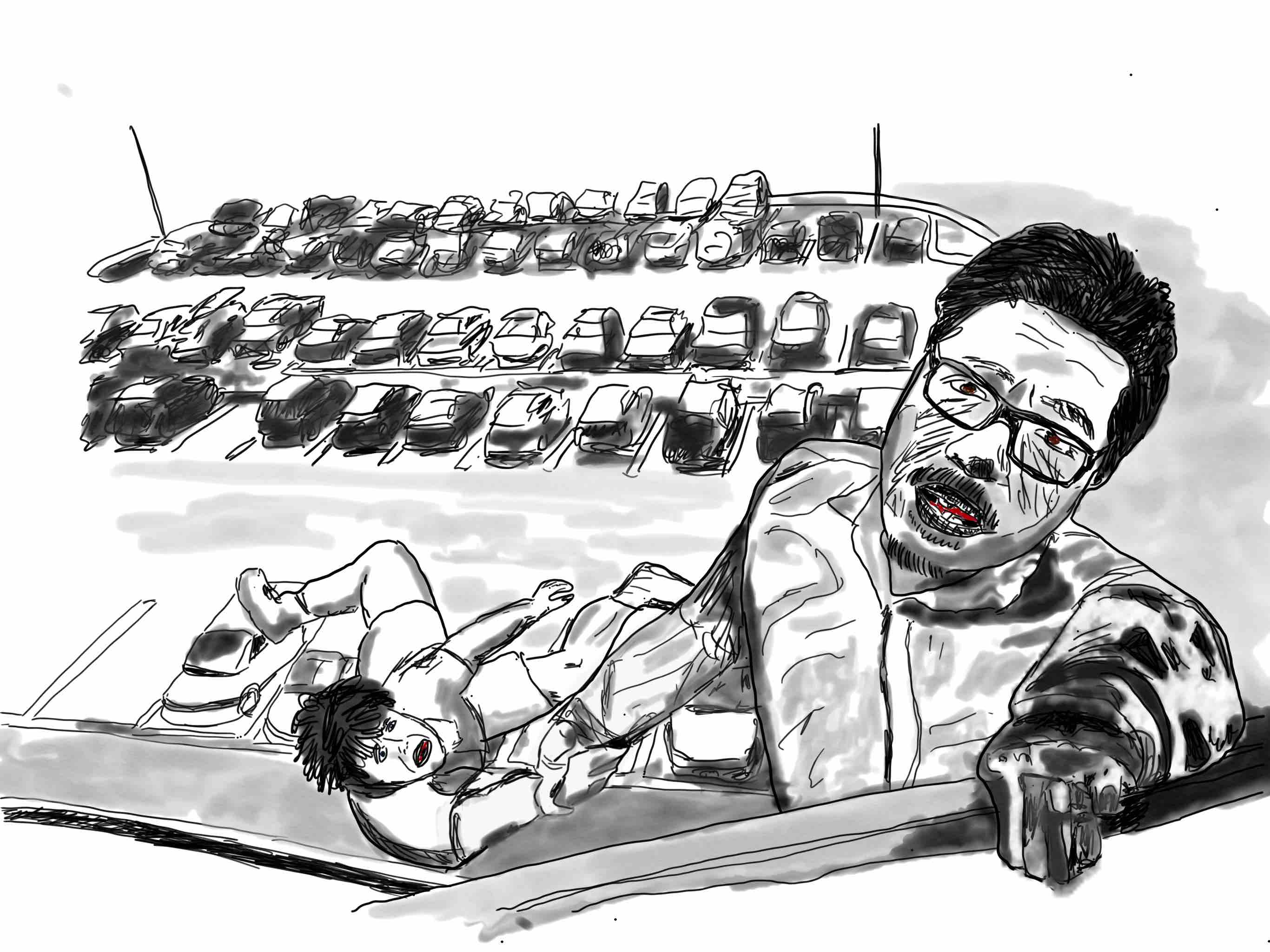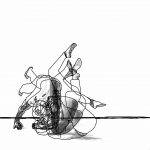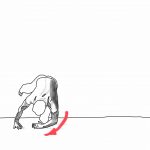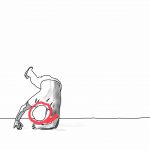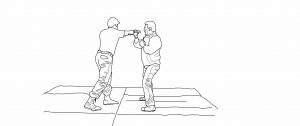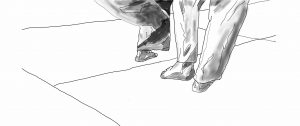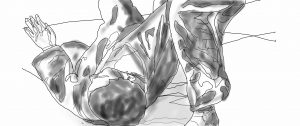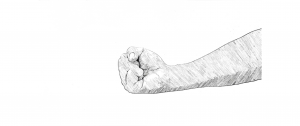Practical Tips … and other problematic pointers**
How to make Hakka Drunken Chicken
How to fall
Falling is inevitable. It doesn’t matter how big and strong you are, one day, you’re going to run into something even bigger and stronger: Planet Earth. So it’s advisable to learn how to fall with grace and the minimum of fuss.
Principles before practice
Unless you are facing a particularly skilled (and malicious) opponent, the main force that is applied to you as you fall is the force of gravity. Gravity takes you in a straight line towards the centre of the Earth at a considerable rate of acceleration – 9.8 meters per second squared, if you recall your high school physics.
The main principles of falling involve dissipating this acceleration, so the effective force on any part of your body – especially your head, shoulders and spine – is minimised. This is achieved by getting the force vector to deflect from its straight line, dissipating the force.
Taking this principle to its logical conclusion, if you can deflect the gravitational force vector (taking you straight towards the centre of the Earth), on a small but continual basis before you reach the Earth’s surface, you will experience the least impact. When you add these small deflections together, they make the force vector look like a curve.
So it’s no accident that many fall breaks involve curving your body, by:
1. Extending the arm in a curved fashion: This is perhaps the main ‘natural instinct’ to overcome for most. Most untrained people will stick their arms straight out. If they do this, they are not dissipating the force of gravity, but instead transferring an impact to the body or head onto the hand and arm joints, risking a break somewhere in the arm or hand. If you are ‘hypermobile’ and your arm moves beyond a straight line at the elbow joint when you extend it, you have a special risk of breaking that elbow.
2. Tucking your head in: When in an upright position, the head, ‘sticks out’ and is vulnerable to being smashed against the ground. Hone and harness your natural instinct to tuck your head in.
3. Curling in your shoulder: This is so you land on the back of your shoulder, and not on the point of it. Failure to curl in your shoulder promptly is liable to end in a dislocated shoulder, or worse.
4. Arching in your back, like a tortoise shell: This protects the lower back from smashing into the ground.
5. Rolling into a ball for a period of time sufficient to dissipate the main force of the fall. This protects the hips and legs from smashing into the ground, and from rolling over only enough to smash your head into the ground on the second revolution.
With practice, the fall should look like one smooth action, like so:

How to ‘catch’ a punch
A punch is one of the most common physical attacks. No form of self-defence is complete without a suitable response to it.
Step 1: Relax
Step 2: As your assailant begins to throw his/her punch try to estimate the line of the punch and shift your body perpendicular to its trajectory. If the punch comes from his/her right, shift to your left. If the punch comes from his/her left, shift to your right. Practice makes perfect.
Step 3: Raise your open hand, poised to catch your assailant’s wrist on its way past you. If your opponent has thrown a ‘right punch’, use your right hand. If your opponent has thrown a ‘left punch’, use your left hand. It is best to practice this with a friend who is using unclenched fists, or soft sparring gloves.
Step 4: As your assailant’s punch reaches full extension, you can either deflect it with your outer forearm, or catch it. If you can catch it, you are setting yourself up well for tripping your opponent (c.f.)
Step 5: If you succeed in catching your assailant’s punch, pull on their wrist along the line it came, making sure you ‘go with the flow’ of momentum. Stick the appropriate leg out if you wish to trip your assailant: i.e. your right leg if you are pulling them across to your right; your left leg if you are pulling them across to your left.
String it all together, and it looks something like this: (click on the image to activate the GIF animation)
How to trip
There are few pleasures in life quite as satisfying as using your opponent’s own force to make them fall flat on their face. The trip is the first of many useful ‘take-downs’ every martial artist should have in her repertoire. You can learn how to trip in 5 easy steps.
Step 1. Grab hold of your opponent, preferably at a point – as far as is practical – away from your assailant’s target foot. If you have ‘caught’ your opponent’s punch (see above ‘How to catch a punch’), then that is a good start.
Step 2. Stick whichever of your two feet out that you are not resting upon, into the path of your opponent. In the diagram above, the weight is on the tripper’s left foot, so he should stick out his right foot. Ideally, you sweep your free leg just as s/he is about to plant their foot. The foot that your assailant is committing weight to, or about to commit weight to, is the ‘target foot’ in this example.
Step 3. As they commit their weight to that foot … trip! (or ‘sweep’)
Step 4. Let your opponent’s momentum – and gravity – do the rest.
Step 5. Ta-dah!
The complete trip looks something like this: (Click on the image to activate the GIF animation)
Step 6. Now that your opponent is down (fingers and toes crossed for this to happen) you are in a strong position to win the fight. But don’t kid yourself that the fight is won just yet. Experience says that if you just let them up, they will attribute their fall to ‘bad luck’, and will get up forewarned of your trip, their motivation to beat you to a pulp still intact. You’ve been warned.
How to clench a fist
Life getting you down? Feel like smashing someone’s face in? It all starts with a bunched fist. Here’s how, in 6 easy steps:
Step 1. Lay your open palm out skywards
Step 2. Roll your fingers in as tightly as you can. If possible, roll your fingers in front of the main, central crease in your palm.
Step 3. Once your nails are biting into your palm, squeeze your fingers as tight as you can.
Step 4. Your fingers should be in tension, wanting to unfurl. Use your thumb to ‘lock in’ the fingers.
Step 5. This is what a fist should look like from side-on.
Step 6. This is what a fist should look like from front-on. Note, you are aiming to strike your target with the leading two knuckles (circled in red).
String it all together, and it should look like this: (Click on the picture below to animate the GIF)
How to make Hakka Drunken Chicken
Background on the practical Hakka people
“The Hakkas have had a significant influence, disproportionate to their smaller total numbers, on the course of modern Chinese and overseas Chinese history, particularly as a source of revolutionary, political and military leaders.” – Wikipedia entry on Hakka People[1]
The Hakka people are a tribe of Han Chinese who are reputed to have fled their homeland in Northern China. Many settled in the South in provinces such as Guangdong and Fujian. The name ‘Hakka’ literally means ‘guest families’.
Wikipedia[2] notes Hakka were somewhat disliked by incumbents from those areas, probably due to conflict over land. This anti-Hakka sentiment was especially prevalent amongst Cantonese people where many Hakka settled. Hakka were seen as barbarians and closely related to tribal people by the Cantonese. In many ways, I imagine this anti-Hakka sentiment (and South-East Asian anti-Chinese sentiment more generally) has similarities to that held by some towards the Roma people and Jewish Diaspora.
The Hakka’s arrival after the incumbents frequently meant they ended up with the worst farming land. As a consequence, a disproportionate number entered the less prestigious[3] merchant class and made their way overseas (usually South East Asia) to make their fortune. They are disproportionately represented amongst the Chinese Diaspora.
As described elsewhere on this site, other Chinese often view the Hakka as clannish and tough. A disproportionate number of revolutionary, political and military leaders claim Hakka descent (see above): a feature shared amongst those who have nothing left to lose.
Hakka Drunken Chicken in Wine Recipe
I like to imagine this dish evolved as a consequence of the harsh conditions experienced by the Hakka.
Practically-speaking, lacking fresh food – due to the aforementioned lack of viable land – the Hakka, like the inland Sichuanese, would have taken to preserving their food. And as happened elsewhere, they developed a taste for characteristics that came with the method of preservation. Hence, Sichuanese food is spicy and salty; Hakka like their food soaked in alcohol … and Australians love their beer icy cold.
In my mind’s eye though, I picture them, streams of refugees along the roadside with nothing but their beloved clay pots and rice wine on their backs. Weary from fleeing their war-torn homeland, they settle after a hard day’s slog to make some comfort food: Something hot to stave off the northern night chill; a generous drop of rice wine to cleanse the memory of recent troubles.
Recipe 1: Source: http://dailycookingquest.com/by-category/main-dish/chicken-in-chinese-rice-wine
Cuisine: Chinese
Prep time: 15 mins
Cook time: 1 hour 15 mins
Total time: 1 hour 30 mins
Serves: 4
Ingredients
- 1 tablespoon oil
- 100 gram ginger (old one is better), peeled and bruised
- 1 whole free range chicken (Indonesian: ayam kampung), cut into 8 pieces
- 3 slices of angelica root (Chinese: dang gui)
- 8 dried jujube fruits/red dates (Chinese: hong zao)
- 1 tablespoon dried goji berries/wolfberries (Chinese: gou gi zi)
- 400 ml Chinese yellow rice wine (Chinese: huang jiu)
- 200 ml Chinese white rice wine (Chinese: bai jiu)
- 50 gram rock sugar
- ½ teaspoon salt
Instructions
- Heat oil in a pot and fry ginger until fragrant, about 3 minutes.
- Add chicken pieces and cook until no longer pink, about 2 minutes.
- Add angelica root, jujube fruit, goji berries, yellow rice wine, and white rice wine. Mix well and bring to a boil.
- Season with rock sugar and salt. Reduce heat and simmer for 1 hour.
- Remove from heat and serve immediately.
Recipe 2: Source: http://www.feasttotheworld.com/2014/02/hakka-yellow-glutinous-rice-wine-chicken.html
Ingredients
1kg small chicken, cut into bit-size pieces or alternatively use thighs and drumsticks
4 slices ginger, lightly bruised
2 tbsp sesame oil
350ml yellow glutinous rice wine (do not confuse this with shaoxing wine)
100ml water, you might not need to use all
4-5 pieces dried black fungus, soaked in warm water for 20 minutes, drained and cut into rough pieces
1 tsp sugar
salt, to taste
1 spring onion, only the green part, cut into rings
Method
Soak the clay pot, if using, in water for 1 hour before using. This stop it from cracking when cooking.
Heat the sesame oil in a wok over medium heat. Add the ginger slice and stir-fry for about 1 minute, until fragrant.
Add the chicken pieces and continue to stir-fry for 5 minutes, until lightly browned on all sides.
Add 200ml of glutinous rice wine, black fungus, sugar and bring to the boil.
Transfer the contents to a clay pot and add enough water to cover the chicken. Cover with a lid and bring to the boil before turning down the heat to low and gently simmer for 15-20 minutes, stirring occasionally, until the chicken is cooked through.
[1]https://en.wikipedia.org/wiki/Hakka_people#Revolutionary.2C_political_and_military_leadership
[2] https://en.wikipedia.org/wiki/Hakka_people#Anti-Hakka_sentiment
[3] Owning land has long been esteemed by the Chinese. It is no surprise that as soon as the shackles on private land ownership were lifted, a massive property boom has emerged in contemporary China.
**Disclaimer 2
Advice and Humour Disclaimer: The advice on this website is meant for the purposes of humour only, and is not meant as real advice.
If you do not find the content funny, no offence is ever intended, but if offended please accept this disclaimer as a blanket apology.
If you remain offended, or cannot tell the difference between a) what is intended as humour and b) what might be intended as real advice (which this website is not), you should ask your doctor a) if this humour is right for you or b) ‘What is humour?’ No doubt they will provide you with a series of terrible jokes.***
Common side effects include i) a sudden impulse to troll in the comments section with terrible spelling ii) gagging, and iii) the ennui of long repressed self-abhorrence. If such reactions persist, we advise respectively:
i) Use a spellchecker
ii) Turn the gag into a puke. Better out than in.
iii) A Bex and a lie-down.
If you do find this content funny, we recommend the same.
We are an inclusive and equal opportunity offender. Should this website have omitted anyone, please contact us with a (spell-checked) description.
***No offence is intended towards doctors. Some of my best friends are doctors (if you are one of them, please refer to Disclaimer 1 above) and they all tell amazing jokes.
****No animals were harmed in the making of this disclaimer.
